
Goliad, Texas
Encyclopedia
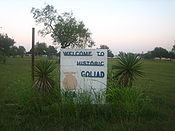
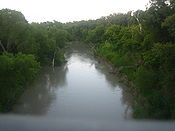
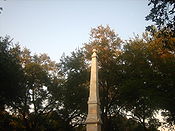
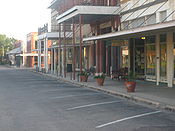
Texas
Texas is the second largest U.S. state by both area and population, and the largest state by area in the contiguous United States.The name, based on the Caddo word "Tejas" meaning "friends" or "allies", was applied by the Spanish to the Caddo themselves and to the region of their settlement in...
, United States
United States
The United States of America is a federal constitutional republic comprising fifty states and a federal district...
. It had a population of 1975 at the 2000 census
Census
A census is the procedure of systematically acquiring and recording information about the members of a given population. It is a regularly occurring and official count of a particular population. The term is used mostly in connection with national population and housing censuses; other common...
. Founded on the San Antonio River
San Antonio River
The San Antonio River is a major waterway that originates in central Texas in a cluster of springs in north central San Antonio, approximately four miles north of downtown, and follows a roughly southeastern path through the state. It eventually feeds into the Guadalupe River about ten miles from...
, it is the county seat
County seat
A county seat is an administrative center, or seat of government, for a county or civil parish. The term is primarily used in the United States....
of Goliad County. It is part of the Victoria, Texas
Victoria, Texas
Victoria is a city in and the seat of Victoria County, Texas, United States. The population was 60,603 at the 2000 census. The three counties of the Victoria Metropolitan Statistical Area had a population of 111,163 at the 2000 census,...
Metropolitan Statistical Area
Victoria metropolitan area
The Victoria Metropolitan Statistical Area, as defined by the United States Census Bureau, is an area consisting of three counties in the Coastal Bend region of Texas, anchored by the city of Victoria. The area is sometimes referred to as the Golden Crescent Region, though this term is sometimes...
. Goliad is located on U.S. Highway 59, named also for the late U.S. Senator Lloyd M. Bentsen.
Spain
In 1747, the Spanish government sent José de EscandónJosé de Escandón
José de Escandón y Helguera, 1st Count of Sierra Gorda was a Spanish Indian-fighter in New Spain and the founder and first governor of the colony of Nuevo Santander, which extended from the Pánuco River in the modern-day Mexican state of Veracruz to the Guadalupe River in...
to inspect the northern frontier of its North American colonies, including Spanish Texas
Spanish Texas
Spanish Texas was one of the interior provinces of New Spain from 1690 until 1821. Although Spain claimed ownership of the territory, which comprised part of modern-day Texas, including the land north of the Medina and Nueces Rivers, the Spanish did not attempt to colonize the area until after...
. In his final report, Escandónt recommended that Presidio La Bahia
Presidio La Bahía
The Presidio Nuestra Señora de Loreto de la Bahía, known more commonly as Presidio La Bahia, or simply La Bahia is a fort constructed by the Spanish Army that became the nucleus of the city of Goliad, Texas, United States. Originally founded in 1721 on the ruins of the failed French Fort Saint...
be moved from its Guadalupe River
Guadalupe River (Texas)
The Guadalupe River runs from Kerr County, Texas to San Antonio Bay on the Gulf of Mexico. The river is a popular destination for rafters and canoers. Larger cities along the river include New Braunfels, Kerrville, Seguin, Gonzales, Cuero, and Victoria...
location to the banks of the San Antonio River, so that it could better assist settlements along the Rio Grande
Rio Grande
The Rio Grande is a river that flows from southwestern Colorado in the United States to the Gulf of Mexico. Along the way it forms part of the Mexico – United States border. Its length varies as its course changes...
. Both the presidio and the mission it protected, Mission Nuestra Señora del Espíritu Santo de Zúñiga
Mission Nuestra Señora del Espíritu Santo de Zúñiga
Mission Nuestra Señora del Espíritu Santo de Zúñigaalso known as Aranama Mission orMission La Bahiawas a Roman Catholic mission established by Spain in Victoria County, Texas in northern New Spain in 1722 to convert local Native Karankawa Indians to Christianity...
, likely moved to their new location in October 1749. Escandón proposed that 25 Mexican families be relocated near the presidio to form a civilian settlement, but he was unable to find enough willing settlers.
With the conclusion of the Seven Years War in 1763, France ceded Louisiana and its claims to Texas, to Spain. With France no longer a threat to the Crown's North American interests, the Spanish monarchy commissioned the Marquis de Rubi to inspect all of the presidios on the northern frontier of New Spain and make recommendations for the future. Rubi recommended that several presidios be closed, but that La Bahia be kept and rebuilt in stone. La Bahia was soon "the only Spanish fortress for the entire Gulf Coast from the mouth of the Rio Grande to the Mississippi River
Mississippi River
The Mississippi River is the largest river system in North America. Flowing entirely in the United States, this river rises in western Minnesota and meanders slowly southwards for to the Mississippi River Delta at the Gulf of Mexico. With its many tributaries, the Mississippi's watershed drains...
." The presidio was at the crossroads of several major trade and military routes. It quickly became one of the three most important areas in Texas, alongside Béxar and Nacogdoches. A civil settlement, then known as La Bahia, soon developed near the presidio. By 1804 the settlement had one of only two schools in Texas.
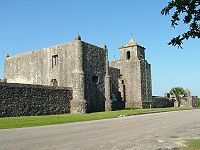


Mexican War of Independence
The Mexican War of Independence was an armed conflict between the people of Mexico and the Spanish colonial authorities which started on 16 September 1810. The movement, which became known as the Mexican War of Independence, was led by Mexican-born Spaniards, Mestizos and Amerindians who sought...
, Mexican revolutionary Bernardo Gutiérrez de Lara
Bernardo Gutiérrez de Lara
Bernardo Gutiérrez de Lara was the first constitutional governor of the state of Tamaulipas, and a native of Revilla, today Ciudad Guerrero, Mexico.-Biography:...
and his recruits, called the Republican Army of the North, invaded Texas. In November, the invaders captured Presidio La Bahia. For the next four months, Texas governor
Governor
A governor is a governing official, usually the executive of a non-sovereign level of government, ranking under the head of state...
Manuel María de Salcedo
Manuel María de Salcedo
Manuel María de Salcedo y Quiroga , Manuel María de Salcedo y Quiroga , Manuel María de Salcedo y Quiroga , (Malaga, Spain, (1776 - executed, 3 April 1813), was a governor of Spanish Texas from 1808 until his execution in 1813. Salcedo gained leadership experience helping his father Juan Manuel de...
laid siege to the fort. Unable to win a decisive victory, Salcedo lifted the siege on February 19, 1813 and turned toward San Antonio de Bexar. The rebels controlled the presidio until July or August 1813, when José Joaquín de Arredondo
Jose Joaquín de Arredondo
Joaquín de Arredondo y Mioño was a 19th-century Spanish–Mexican soldier who served as Chief Civil and Military Commandant of Texas during the first Texas revolution.-Early life:...
led royalist troops in retaking all of Texas. Henry Perry, a member of the Republican Army of the North, led forces back to Texas in 1817 and attempted to recapture La Bahia. The Mexicans reinforced the presidio with soldiers from San Antonio, and defeated Perry's forces on June 18 near Coleto Creek.
The area was invaded again in 1821. The United States and Spain signed the Adams-Onís Treaty
Adams-Onís Treaty
The Adams–Onís Treaty of 1819, also known as the Transcontinental Treaty or the Purchase of Florida, was a treaty between the United States and Spain in 1819 that gave Florida to the U.S. and set out a boundary between the U.S. and New Spain . It settled a standing border dispute between the two...
, giving all rights to Texas to Spain. On October 4, the 52 members of the Long Expedition
Long expedition
The Long Expedition was an 1819 attempt to take control of Spanish Texas. It was led by James Long and successfully established a small independent government, known as the Republic of Texas . The expedition crumbled later in the year, as Spanish troops drove the invaders out...
captured La Bahia. Four days later, Colonel Ignacio Pérez arrived with troops from Bexar; Long surrendered. By the end of 1821, Mexico had achieved its independence from Spain, and Texas became part of the newly created country.
Mexico
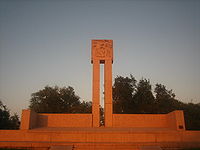
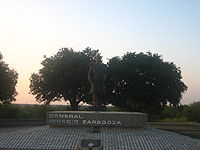

Anagram
An anagram is a type of word play, the result of rearranging the letters of a word or phrase to produce a new word or phrase, using all the original letters exactly once; e.g., orchestra = carthorse, A decimal point = I'm a dot in place, Tom Marvolo Riddle = I am Lord Voldemort. Someone who...
of Hidalgo (omitting the silent initial "H"), in honor of the patriot priest Miguel Hidalgo
Miguel Hidalgo
Miguel Gregorio Antonio Ignacio Hidalgo y Costilla y Gallaga Mandarte Villaseñor , more commonly known as Miguel Hidalgo y Costilla or simply Miguel Hidalgo, was a Mexican priest and a leader of the Mexican War of Independence.In 1810 Hidalgo led a group of peasants in a revolt against the dominant...
, the father of Mexico
Mexico
The United Mexican States , commonly known as Mexico , is a federal constitutional republic in North America. It is bordered on the north by the United States; on the south and west by the Pacific Ocean; on the southeast by Guatemala, Belize, and the Caribbean Sea; and on the east by the Gulf of...
's independencia
Mexican War of Independence
The Mexican War of Independence was an armed conflict between the people of Mexico and the Spanish colonial authorities which started on 16 September 1810. The movement, which became known as the Mexican War of Independence, was led by Mexican-born Spaniards, Mestizos and Amerindians who sought...
.
On October 9, 1835, in the early days of the Texas Revolution
Texas Revolution
The Texas Revolution or Texas War of Independence was an armed conflict between Mexico and settlers in the Texas portion of the Mexican state Coahuila y Tejas. The war lasted from October 2, 1835 to April 21, 1836...
, a group of Texian
Texian
Texian is an archaic, mostly defunct 19th century demonym which defined a settler of current-day Texas, one of the southern states of the United States of America which borders the country of Mexico...
s attacked the presidio in the Battle of Goliad
Battle of Goliad
The Battle of Goliad was the second skirmish of the Texas Revolution. In the early-morning hours of October 10, 1835, rebellious Texas settlers attacked the Mexican Army soldiers garrisoned at Presidio La Bahía, a fort near the Mexican Texas settlement of Goliad...
. The Mexican garrison quickly surrendered, leaving the Texians in control of the fort. The first declaration of independence
Texas Declaration of Independence
The Texas Declaration of Independence was the formal declaration of independence of the Republic of Texas from Mexico in the Texas Revolution. It was adopted at the Convention of 1836 at Washington-on-the-Brazos on March 2, 1836, and formally signed the following day after errors were noted in the...
of the Republic of Texas
Republic of Texas
The Republic of Texas was an independent nation in North America, bordering the United States and Mexico, that existed from 1836 to 1846.Formed as a break-away republic from Mexico by the Texas Revolution, the state claimed borders that encompassed an area that included all of the present U.S...
was signed here on December 20, 1835. Texians held the area until March 1836, when their garrison under Colonel
Colonel
Colonel , abbreviated Col or COL, is a military rank of a senior commissioned officer. It or a corresponding rank exists in most armies and in many air forces; the naval equivalent rank is generally "Captain". It is also used in some police forces and other paramilitary rank structures...
James Fannin
James Fannin
James Walker Fannin, Jr. was a 19th-century U.S. military figure on the Texas Army and leader during the Texas Revolution of 1835–36...
was defeated at the nearby Battle of Coleto
Battle of Coleto
The Battle of Coleto, also known as the Battle of Coleto Creek, the Battle of the Prairie, and the Batalla del encinal del Perdido, was fought on March 19 and 20, 1836, during the Goliad campaign of the Texas Revolution...
. Santa Anna ordered that all survivors were to be executed. On Palm Sunday
Palm Sunday
Palm Sunday is a Christian moveable feast that falls on the Sunday before Easter. The feast commemorates Jesus' triumphal entry into Jerusalem, an event mentioned in all four Canonical Gospels. ....
, March 27, 1836, in what was later called the Goliad Massacre
Goliad massacre
The Goliad Massacre was an execution of Republic of Texas soldiers and their commander, James Fannin, by Mexico, reluctantly carried out by General Jose de Urrea.-Background:...
, 303 were marched out of the fort to be executed, 39 were executed inside the presidio (20 prisoners were spared because they were either physicians or medical attendants). 342 men were killed and 28 escaped.
Goliad was the birthplace of the famous Mexican General Ignacio Zaragoza
Ignacio Zaragoza
Ignacio Zaragoza Seguín was a general in the Mexican army, best known for defeating invading French forces at the Battle of Puebla on May 5, 1862 ....
, commander against the French Army
French Army
The French Army, officially the Armée de Terre , is the land-based and largest component of the French Armed Forces.As of 2010, the army employs 123,100 regulars, 18,350 part-time reservists and 7,700 Legionnaires. All soldiers are professionals, following the suspension of conscription, voted in...
in the battle of Cinco de Mayo
Cinco de Mayo
Cinco de Mayo is a holiday held on May 5. It is celebrated nationwide in the United States and regionally in Mexico, primarily in the state of Puebla, where the holiday is called El Dia de la Batalla de Puebla...
on May 5, 1862.
United States
On May 18, 1902, a devastating tornado struck Goliad, killing 114 people. It is tied for the deadliest tornado in Texas history and the 10th deadliest in the United States.Geography
Goliad is located at 28°40′8"N 97°23′31"W (28.668865, -97.391850).According to the United States Census Bureau
United States Census Bureau
The United States Census Bureau is the government agency that is responsible for the United States Census. It also gathers other national demographic and economic data...
, the city has a total area of 1.5 square miles (3.9 km²), all of it land.

Demographics
As of the censusCensus
A census is the procedure of systematically acquiring and recording information about the members of a given population. It is a regularly occurring and official count of a particular population. The term is used mostly in connection with national population and housing censuses; other common...
of 2000, there were 1,975 people, 749 households, and 518 families residing in the city. The population density
Population density
Population density is a measurement of population per unit area or unit volume. It is frequently applied to living organisms, and particularly to humans...
was 1,294.3 people per square mile (498.4/km²). There were 877 housing units at an average density of 574.7 per square mile (221.3/km²). The racial makeup of the city was 75.44% White, 6.08% African American, 0.35% Native American, 0.61% Asian, 14.99% from other races
Race (United States Census)
Race and ethnicity in the United States Census, as defined by the Federal Office of Management and Budget and the United States Census Bureau, are self-identification data items in which residents choose the race or races with which they most closely identify, and indicate whether or not they are...
, and 2.53% from two or more races. Hispanic or Latino of any race were 49.72% of the population.
There were 749 households out of which 33.9% had children under the age of 18 living with them, 51.7% were married couples
Marriage
Marriage is a social union or legal contract between people that creates kinship. It is an institution in which interpersonal relationships, usually intimate and sexual, are acknowledged in a variety of ways, depending on the culture or subculture in which it is found...
living together, 12.8% had a female householder with no husband present, and 30.8% were non-families. 28.7% of all households were made up of individuals and 15.8% had someone living alone who was 65 years of age or older. The average household size was 2.49 and the average family size was 3.04.
In the city, the population was spread out with 26.3% under the age of 18, 7.2% from 18 to 24, 24.4% from 25 to 44, 21.3% from 45 to 64, and 20.8% who were 65 years of age or older. The median age was 39 years. For every 100 females there were 91.0 males. For every 100 females age 18 and over, there were 84.1 males.
The median income for a household in the city was $26,200, and the median income for a family was $33,438. Males had a median income of $28,889 versus $20,167 for females. The per capita income
Per capita income
Per capita income or income per person is a measure of mean income within an economic aggregate, such as a country or city. It is calculated by taking a measure of all sources of income in the aggregate and dividing it by the total population...
for the city was $13,997. About 19.7% of families and 23.1% of the population were below the poverty line, including 31.5% of those under age 18 and 17.6% of those age 65 or over.
Attractions
- Texas Mile - a weekend Motorsports racing festival is held twice a year (March and October) at the Goliad Airport near Berclair, Texas.
- Goliad market days (held on the second saturday of every month), where produce, arts and crafts and other retail items are sold.
Businesses
Goliad Farms, 12 miles from the city center, is one of the largest tropical fishTropical fish
Tropical fish include fish found in tropical environments around the world, including both freshwater and salt water species.Tropical fish are popular as aquarium fish, due to their often bright coloration...
hatcheries in Texas.
External links
- City of Goliad
- http://www.tshaonline.org/handbook/online/articles/GG/hjg5.html Handbook of TexasHandbook of TexasThe Handbook of Texas is a comprehensive encyclopedia of Texas geography, history, and historical persons published by the Texas State Historical Association .-History:...
Online article - Texas Mile Official Site

